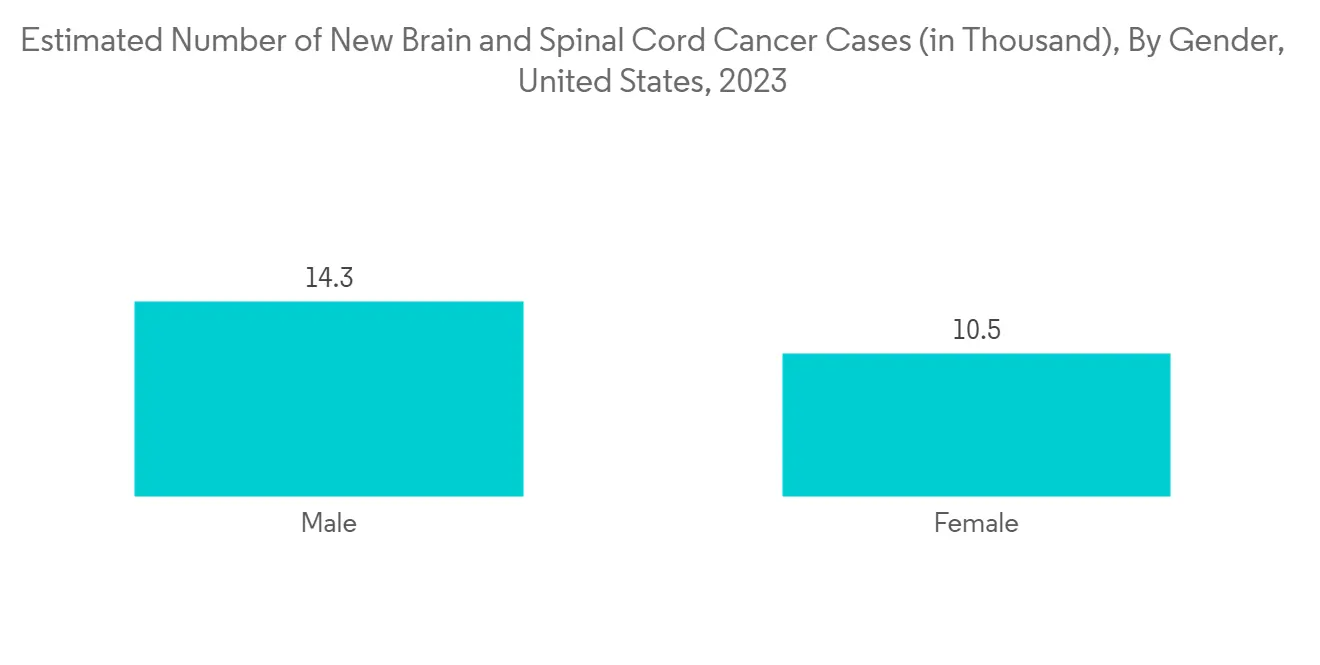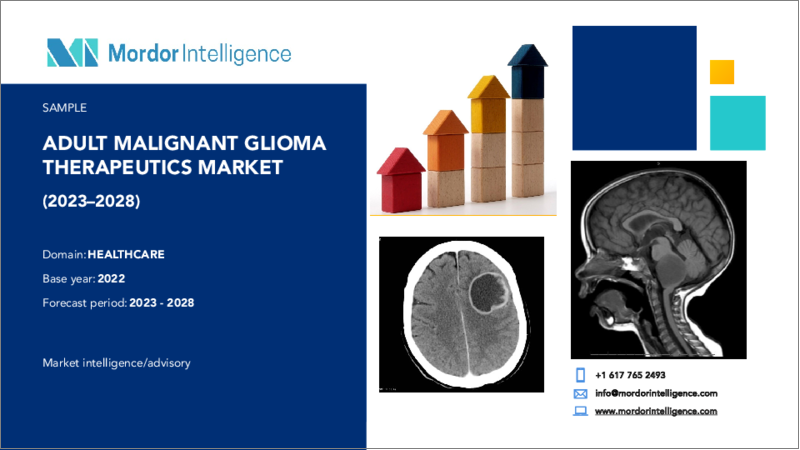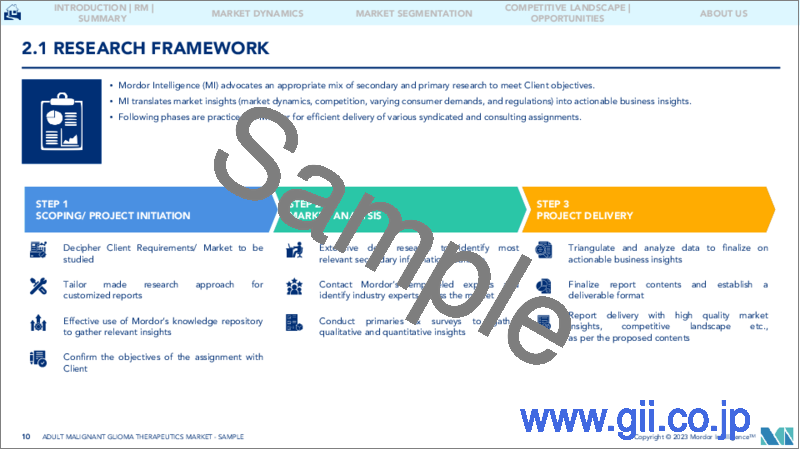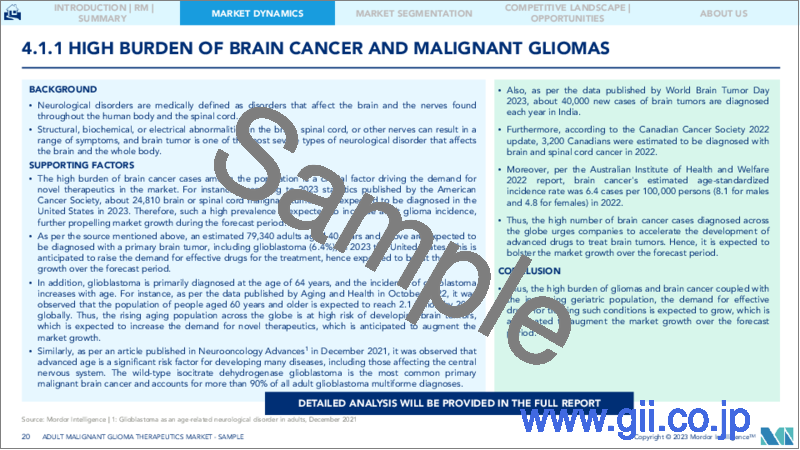|
|
市場調査レポート
商品コード
1272672
成人悪性神経膠腫治療市場- 成長、動向、予測(2023年-2028年)Adult Malignant Glioma Therapeutics Market - Growth, Trends, and Forecasts (2023 - 2028) |
||||||
|
● お客様のご希望に応じて、既存データの加工や未掲載情報(例:国別セグメント)の追加などの対応が可能です。 詳細はお問い合わせください。 |
|||||||
| 成人悪性神経膠腫治療市場- 成長、動向、予測(2023年-2028年) |
|
出版日: 2023年04月14日
発行: Mordor Intelligence
ページ情報: 英文 116 Pages
納期: 2~3営業日
|
- 全表示
- 概要
- 目次
成人悪性神経膠腫治療市場は、予測期間中に9.6%のCAGRで推移すると予測されています。
COVID-19のパンデミックは、治療の遅れだけでなく、臨床試験の中断など、がん医療に広く混乱をもたらしました。例えば、2021年6月に発表された論文によると、COVIDのパンデミックの間、腫瘍学サービスの提供はかなり減少しました。COVID-19は、悪性脳腫瘍の方にも悪影響を及ぼしました。例えば、2022年7月にActa Medicaに掲載された論文では、腫瘍疾患や抗がん剤治療に関連する免疫低下により、がん患者はCOVID-19に弱く、集中治療を要する重度の合併症のリスクも高かったと述べています。しかし、規制が解除され、神経膠腫治療薬開発のための試験が再開されたため、ここ数年で市場は回復しています。COVID-19は、現在のシナリオでは成人悪性神経膠腫治療市場に与える影響はごくわずかであり、予測期間中も安定した成長率を示すと予想されます。
世界的に脳腫瘍や悪性グリオーマの負担が大きいことが、市場の成長を促進すると予想されます。例えば、カナダがん協会2022年最新情報によると、2022年に3,200人のカナダ人が脳腫瘍および脊髄がんと診断されると推定されます。また、オーストラリア保健福祉研究所2022年報告書によると、2022年の脳腫瘍の推定年齢標準化発症率は10万人あたり6.4件(男性8.1件、女性4.8件)です。
さらに、悪性グリオーマ治療薬の研究開発(R&D)を促進するための政府機関の資金調達や関与の高まりも、市場の成長に大きく寄与しています。例えば、2022年10月、オーストラリア政府は脳腫瘍研究を支援するために540万米ドル以上を提供しました。この資金は、Medical Research Future Fund(MRFF)からのものです。また、2021年9月には、NCIが出資する膠芽腫治療ネットワーク(GTN)が、悪性神経膠腫の新しい治療法を開発するために協力することを報告しました。革新的な治療薬開発のための資金調達やパートナーシップの高まりは、市場の成長を促進すると期待されます。
成人悪性グリオーマ治療薬を拡大するための製品承認、発売、パートナーシップなどの市場プレイヤーの戦略的イニシアチブは、市場成長を増強すると予想されます。例えば、2021年12月、Sapience Therapeutics, Inc.は、再発性膠芽腫(GBM)を治療するためのST101を調査するリードプログラムに米国食品医薬品局(FDA)からファーストトラック指定を付与されました。ファストトラック指定は、重篤な疾患の治療薬の審査を迅速化するものであり、市場の成長を促進します。
したがって、脳腫瘍の高い負担、研究開発費の増加、市場関係者による製品の承認や発売などの要因により、調査対象市場は分析期間中に成長を示すと予想されます。しかし、化学療法への嗜好の低下や、神経膠腫の新規治療薬の承認率の低さが、市場の成長を抑制すると推定されます。
成人悪性神経膠腫治療の市場動向
予測期間中、多形膠芽腫セグメントが大きな成長を維持すると予測される
多形膠芽腫(GBM)は、最も攻撃的なタイプの脳腫瘍の1つです。この分野は、市場開拓の増加や革新的な治療薬の承認取得の増加により、予測期間中に成長すると予想されます。
政府機関や様々な市場関係者による臨床試験開発の増加は、このセグメントの成長に大きく寄与しています。例えば、clinicaltrials.orgによると、2023年2月17日現在、募集中、活動中、募集なし、招待による登録というステータスで、成人の多形膠芽腫に対して144件の試験が進行中です。脳の多形膠芽腫に対する試験件数が多いことから、予測期間中にセグメントの成長を促進することが期待されます。
多形膠芽腫の治療に対する革新的な治療薬の承認の高まりは、市場の成長を促進すると予想されます。例えば、2022年12月、FDAは多形性膠芽腫の治療薬としてWP1122にファストトラック指定を付与しました。この薬剤はMoleculin Biotech, Inc.によって開発されており、現在WP1122の臨床開発に向けて共同研究の機会を検討しています。前臨床試験によると、WP1122(2-デオキシ-D-グルコース、または2-DG)は、2-DGの細胞への取り込みを増加させ、薬物半減期を増加させ、血液脳関門を通過する能力を高め、脳への取り込みを高めることが示されています。
さらに、2022年4月、CNSファーマシューティカルズ社は、再発性多形性膠芽腫(GBM)の治療に対するベルビシンの重要な試験について、フランスの国立医薬品・健康製品安全庁(ANSM)管轄当局および国民保護倫理委員会(EC) SUD-EST III(CPP Sud-Est III)から承認を取得しました。このような先進的な治療薬の承認や上市は、予測期間中の同分野の成長を促進すると期待されます。

予測期間中、北米が最大の市場シェアを占めると予想される
北米は、成人悪性神経膠腫の有病率の高さ、高額な資金提供の存在、それによる継続的な研究、この地域における市場プレイヤーの集中などの要因によって、市場を独占すると予想されます。
米国がん協会(ACS)の2023年版アップデートによると、米国における脳・脊髄腫瘍の推定患者数は、成人・小児を含めて2023年に2万4,800人(男性14,280人、女性10,530人)です。その中でも、グリア細胞から発生する悪性脳腫瘍は、膠芽腫(GBM)と呼ばれ、最も多く発生しています。また、Brain Tumour Registry of Canada 2022 updateによると、カナダにおける膠芽腫(GB)の発生率は10万人あたり4人となっています。したがって、米国では脳や脊髄の悪性腫瘍の負担が大きいことから、成人神経膠腫の発症率が上昇し、予測期間中の市場成長をさらに促進すると予想されます。
さらに、国立衛生研究所、各種研究・状態・疾患カテゴリー(RCDC)の資金調達の見積もり、2022年5月更新によると、米国における脳腫瘍の研究開発への支出は、2021年に4億1,500万米ドル、2022年に4億3,500万米ドルでした。脳腫瘍の研究に対して政府が提供する助成金は、革新的な治療薬を開発することが期待され、今後数年間の市場成長をさらに促進することが期待されます。
さらに、成人悪性グリオーマを調査するための政府および非政府組織による資金提供の増加は、この地域の市場成長を促進すると期待されています。例えば、2021年11月、イェール公衆衛生大学院の科学者・研究者チームは、主に若年成人に発症する、成長は遅いが悪性の脳腫瘍である低悪性度グリオーマの分子進化を調査するために、1,300万米ドルの助成金を授与されました。これらの取り組みにより、成人神経膠腫に対する先進的な治療薬が開発され、市場の成長が促進されると期待されます。
したがって、悪性脳腫瘍の負担が大きいことや、研究開発のために組織が提供する資金などの要因が、予測期間中に同地域の市場成長を加速させると予想されます。

成人悪性神経膠腫治療薬産業の概要
成人悪性神経膠腫治療市場は、さまざまな市場プレイヤーの存在により、その性質上、適度な競争が行われています。競合情勢には、主要または重要な市場シェアを保有する少数の国際企業および地元企業の分析が含まれています。市場で活動している主要なプレーヤーは、Merck &Co.Inc.、F. Hoffmann-La Roche Ltd.、Bio-Rad Laboratories、Azurity Pharmaceuticals, Inc.、Bristol-Myers Squibb Companyなどです。
その他の特典:
- エクセル形式の市場予測(ME)シート
- 3ヶ月間のアナリストサポート
目次
第1章 イントロダクション
- 調査の前提条件と市場定義
- 本調査の対象範囲
第2章 調査手法
第3章 エグゼクティブサマリー
第4章 市場力学
- 市場概要
- 市場促進要因
- 脳腫瘍および悪性グリオーマの高負担率
- 研究開発のための資金調達の増加
- 市場抑制要因
- 化学療法への嗜好の低下
- 神経膠腫に対する新規治療薬の承認率の低さ
- ポーターファイブフォース
- 新規参入業者の脅威
- 買い手/消費者の交渉力
- 供給企業の交渉力
- 代替品の脅威
- 競争企業間の敵対関係
第5章 市場セグメンテーション(市場規模)
- 疾患タイプ別
- 多形膠芽腫
- 退形成性アストロサイトーマ
- 退形成性乏突起膠腫
- 退形成性乏突起星細胞腫
- その他の疾患
- 治療法別
- 化学療法
- テモゾロミド
- ベバシズマブ
- カームスタイン
- その他の化学療法
- 標的薬物療法
- 上皮成長因子受容体(EGFR)阻害剤
- その他モノクローナル抗体
- 放射線療法
- 化学療法
- 地域
- 北米
- 米国
- カナダ
- メキシコ
- 欧州
- ドイツ
- 英国
- フランス
- イタリア
- スペイン
- その他欧州
- アジア太平洋地域
- 中国
- 日本
- インド
- オーストラリア
- 韓国
- その他アジア太平洋地域
- 中東・アフリカ地域
- GCC
- 南アフリカ
- その他中東とアフリカ
- 南米
- ブラジル
- アルゼンチン
- その他南米地域
- 北米
第6章 競合情勢
- 企業プロファイル
- AbbVie, Inc.
- Amgen, Inc.
- Arbor Pharmaceuticals
- Bio Rad Laboratories
- Bristol-Myers Squibb Company
- F. Hoffmann-La Roche Ltd
- Pfizer, Inc.
- Sun Pharmaceuticals Ltd
- Merck & Co. Inc.
第7章 市場機会および将来動向
The adult malignant glioma therapeutics market is projected to register a CAGR of 9.6% during the forecast period.
The COVID-19 pandemic has caused widespread disruption in cancer care, including delays in treatment as well as the suspension of clinical trials. For instance, according to an article published in June 2021, the provision of oncology services was considerably reduced during the COVID pandemic. COVID-19 also had an adverse impact on people with malignant brain tumors. For instance, an article published in Acta Medica in July 2022 stated that due to immunodepression related to tumor disease and anti-cancer treatments, cancer patients were more vulnerable to COVID-19 and had a higher risk of severe complications requiring intensive care. However, the market recovered in the past few years since the restrictions were lifted and trials for the development of glioma therapeutics resumed. COVID-19 has a negligible impact on the adult malignant glioma therapeutics market in the current scenario and is expected to show a stable growth rate during the forecast period.
The high burden of brain cancer and malignant gliomas globally is expected to propel market growth. For instance, according to the Canadian Cancer Society 2022 update, 3,200 Canadians were estimated to be diagnosed with brain and spinal cord cancer in 2022. Also, as per the Australian Institute of Health and Welfare 2022 report, the estimated age-standardized incidence rate for brain cancer was 6.4 cases per 100,000 persons (8.1 for males and 4.8 for females) in 2022.
Furthermore, the rising funding and engagement of government organizations to expedite the malignant gliomas therapeutics research and development (R&D) is also contributing significantly to the market growth. For instance, in October 2022, the Australian Government provided more than USD 5.4 million to support brain cancer research. The funding is from the Medical Research Future Fund (MRFF). Also, in September 2021, the NCI-funded Glioblastoma Therapeutics Network (GTN) reported working collaboratively to develop new treatments for malignant gliomas. The rising funding and partnership for the development of innovative therapeutics are expected to propel market growth.
The strategic initiatives by market players, such as product approvals, launches, and partnerships to expand adult malignant gliomas therapeutics, are expected to augment the market growth. For instance, in December 2021, Sapience Therapeutics, Inc. was granted Fast Track Designation to its lead program investigating ST101 for treating recurrent glioblastoma (GBM) by the United States Food and Drug Administration (FDA). The fast-track designation expedites the review of a drug for treating serious conditions, thereby propelling the market growth.
Therefore, owing to the factors such as the high burden of brain cancer, rising R&D spending, and product approvals and launches by market players, the studied market is anticipated to witness growth over the analysis period. However, the diminishing preference for chemotherapy and low approval rates for novel therapeutics for glioma is estimated to restrain the market growth.
Adult Malignant Glioma Therapeutics Market Trends
The Glioblastoma Multiforme Segment is Expected to Hold a Significant Growth Over The Forecast Period
Glioblastoma Multiforme (GBM) is one of the most aggressive types of brain cancer. The segment is expected to grow during the forecast period owing to the rising number of clinical trial developments and increasing approvals of innovative therapeutics by market players.
The increasing clinical trial developments by government organizations and various market players are significantly contributing to the segment's growth. For instance, as per clinicaltrials.org, 144 trials are ongoing for adult glioblastoma multiforme with the status recruiting, active, not recruiting, enrolling by invitation as of 17th February 2023. The high number of trials for Glioblastoma multiforme of the brain is expected to propel the segment growth during the forecast period.
The rising approvals of innovative therapeutics for the treatment of glioblastoma multiforme are expected to propel the market growth. For instance, in December 2022, the FDA granted Fast Track designation to WP1122 for the treatment of glioblastoma multiforme. The drug is developed by Moleculin Biotech, Inc., which is currently examining collaboration opportunities for the clinical development of WP1122. According to preclinical studies, WP1122 (2-deoxy-D-glucose, or 2-DG) has been shown to increase cellular uptake of 2-DG, increase drug half-life, and increase the ability to cross the blood-brain barrier leading to higher uptake in the brain.
Additionally, in April 2022, CNS Pharmaceuticals, Inc., received approval from the National Agency for the Safety of Medicine and Health Products (ANSM) Competent Authority and from the People Protection Ethics Committee (EC) SUD-EST III (CPP Sud-Est III) in France for the Company's potentially pivotal study of Berubicin for the treatment of recurrent glioblastoma multiforme (GBM). These approvals and launches of advanced therapeutics are expected to propel the segment's growth during the forecast period.

North America is Expected to Hold a Maximum Market Share Over The Forecast Period
North America is expected to dominate the market owing to factors such as the high prevalence of adult malignant glioma, the presence of high funding, and, thereby, ongoing research, along with the high concentration of market players in the region.
According to the American Cancer Society (ACS) 2023 update, the estimated number of brain and spinal cord tumors in the United States, including both adults and children, is 24.8 thousand (14,280 in males and 10,530 in females) in 2023. The most prevalent and malignant brain tumors originating from glial cells are called glioblastomas (GBM). Also, according to the Brain Tumour Registry of Canada 2022 update, the incidence of glioblastoma (GB) is 4 per 100,000 people in Canada. Therefore, the high burden of malignant tumors of the brain or spinal cord in the United States is expected to increase adult glioma incidence, which is further expected to propel the market growth during the forecast period.
Furthermore, according to the National Institute of Health, Estimates of Funding for Various Research, Condition, and Disease Categories (RCDC), May 2022 update, the spending on R&D in the United States for brain cancer was USD 415 million in 2021 and USD 435 million in 2022. The grant provided by the government for the research of brain cancer is expected to develop innovative therapeutics that are further expected to propel market growth in the upcoming years.
Additionally, the rising funding by government and non-government organizations for investigating adult malignant gliomas is expected to propel market growth in the region. For instance, in November 2021, a team of scientists and researchers at the Yale School of Public Health was awarded a USD 13 million grant to study the molecular evolution of lower-grade gliomas, which are slow-growing but malignant brain tumors that primarily affect young adults. These initiatives are expected to develop advanced therapeutics for adult gliomas, thereby propelling the market growth.
Therefore, the factors such as the high burden of malignant brain tumors and funding provided by organizations for R&D are expected to accelerate the market growth in the region during the forecast period.

Adult Malignant Glioma Therapeutics Industry Overview
The adult malignant glioma therapeutics market is moderately competitive in nature due to the presence of various market players. The competitive landscape includes an analysis of a few international as well as local companies which hold major or significant market shares. The key players operating in the market include Merck & Co. Inc., F. Hoffmann-La Roche Ltd, Bio-Rad Laboratories, Azurity Pharmaceuticals, Inc., and Bristol-Myers Squibb Company.
Additional Benefits:
- The market estimate (ME) sheet in Excel format
- 3 months of analyst support
TABLE OF CONTENTS
1 INTRODUCTION
- 1.1 Study Assumptions and Market Definition
- 1.2 Scope of the Study
2 RESEARCH METHODOLOGY
3 EXECUTIVE SUMMARY
4 MARKET DYNAMICS
- 4.1 Market Overview
- 4.2 Market Drivers
- 4.2.1 High Burden of Brain Cancer and Malignant Gliomas
- 4.2.2 Rising Funding for Research and Development
- 4.3 Market Restraints
- 4.3.1 Diminishing Preference for Chemotherapy
- 4.3.2 Low Approval Rates for Novel Therapeutics for Glioma
- 4.4 Porter Five Forces
- 4.4.1 Threat of New Entrants
- 4.4.2 Bargaining Power of Buyers/Consumers
- 4.4.3 Bargaining Power of Suppliers
- 4.4.4 Threat of Substitute Products
- 4.4.5 Intensity of Competitive Rivalry
5 MARKET SEGMENTATION (Market Size by Value- USD million)
- 5.1 By Type of Disease
- 5.1.1 Glioblastoma Multiforme
- 5.1.2 Anaplastic Astrocytoma
- 5.1.3 Anaplastic Oligodendroglioma
- 5.1.4 Anaplastic Oligoastrocytoma
- 5.1.5 Other Types of Disease
- 5.2 By Therapy
- 5.2.1 Chemotherapy
- 5.2.1.1 Temozolomide
- 5.2.1.2 Bevacizumab
- 5.2.1.3 Carmustine
- 5.2.1.4 Other Types of Chemotherapy
- 5.2.2 Targeted Drug Therapy
- 5.2.2.1 Epidermal Growth Factor Receptor (EGFR) Inhibitors
- 5.2.2.2 Other Monoclonal Antibodies
- 5.2.3 Radiation Therapy
- 5.2.1 Chemotherapy
- 5.3 Geography
- 5.3.1 North America
- 5.3.1.1 United States
- 5.3.1.2 Canada
- 5.3.1.3 Mexico
- 5.3.2 Europe
- 5.3.2.1 Germany
- 5.3.2.2 United Kingdom
- 5.3.2.3 France
- 5.3.2.4 Italy
- 5.3.2.5 Spain
- 5.3.2.6 Rest of Europe
- 5.3.3 Asia-Pacific
- 5.3.3.1 China
- 5.3.3.2 Japan
- 5.3.3.3 India
- 5.3.3.4 Australia
- 5.3.3.5 South Korea
- 5.3.3.6 Rest of Asia-Pacific
- 5.3.4 Middle East and Africa
- 5.3.4.1 GCC
- 5.3.4.2 South Africa
- 5.3.4.3 Rest of Middle East and Africa
- 5.3.5 South America
- 5.3.5.1 Brazil
- 5.3.5.2 Argentina
- 5.3.5.3 Rest of South America
- 5.3.1 North America
6 COMPETITIVE LANDSCAPE
- 6.1 Company Profiles
- 6.1.1 AbbVie, Inc.
- 6.1.2 Amgen, Inc.
- 6.1.3 Arbor Pharmaceuticals
- 6.1.4 Bio Rad Laboratories
- 6.1.5 Bristol-Myers Squibb Company
- 6.1.6 F. Hoffmann-La Roche Ltd
- 6.1.7 Pfizer, Inc.
- 6.1.8 Sun Pharmaceuticals Ltd
- 6.1.9 Merck & Co. Inc.




